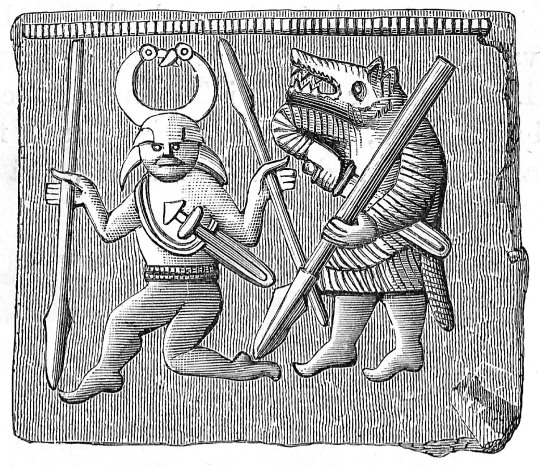Berserkers

There are certainly countless legends in Scandinavia about shape-shifters of all kinds – wolves, bears, boars, and plenty more, such as those of the eigi einhamir (”not of one skin”), who were hamrammr (”shape strong,” stronger than any ordinary man regardless of what form they took) thanks to their powers. But foremost among those are the berserkers, which are perhaps the most famous and most popular of all.
So here’s your werewolf fact for the week: berserkers were much more of werewolves and wolf-warriors than they are bear-warriors, as they are so often portrayed today.
First, let’s get a more general overview of berserkers themselves. They were featured in many different sagas, in which we learn that they are warriors who went into battle wearing the skins of wolves or some other animal. They had the ability to enter a superhuman, primal rage that gave them abilities well beyond a normal person’s – and as a result, they were feared warriors all across Scandinavia and even down into Rome.
Berserkers could endure impossible amounts of pain and perform inhuman feats of strength when they entered into their enraged – or berserk – state, in which they behaved like maddened animals. It was often specified that no one could possibly hope to stand up to a berserker (and, indeed, terms for “werewolf” and “berserker” were often interchangeable, since it seems most berserkers in accounts were simply taken to be werewolves by the very nature of their rage), as they were simply too impossibly strong when they were berserk.
To quote a description of berserkers from an ancient Roman account, “Their eyes glared as though a flame burned in their sockets, they ground their teeth, and frothed at the mouth; they gnawed at their shield rims, and are said to have sometimes bitten them through, and as they rushed into conflict they … howled as wolves.”
So now for some etymology on this bear warrior thing: for years, scholars of all kinds have debated the meaning and origin of the word “berserker.” Some say it comes from words meaning “bare of shirt,” and others say it means “bear-shirt,” implying that they wear bear skins. All my research into the matter and discussion with other scholars, though, has made me take sides with Snorri Sturluson in that it seems the name “berserker” was meant to imply that these warriors often (but not always, as we see in the sagas) wore no shirt.
The idea that they’re “bear-warriors” doesn’t really make much sense, given both the etymology of “berserker” and that the majority of surviving depictions and mentions of berserkers in writing and imagery shows them wearing wolf skins and exhibiting wolf behavior in their rages. There were mentions of bear warriors here and there, too, and certainly bear transformations in Scandinavian folklore, but the berserkers overall seem more closely connected to wolves than bears, both in the stories and etymologically.
So what kind of sagas did they appear in? Well, in the Vatnsdæla Saga, we specifically hear about a commonly mentioned “type” of berserker – the ulfheðnir, or “wolf-shirts.” Then, another example appears in the Holmverja Saga, in which one character is described as being “son of Ulfheðin, wolfskin coat, son of Ulfhamr, wolf-shaped, son of Ulf, wolf, son of Ulfhamr, wolf-shaped, who could change forms.” Long story short, berserkers were very often associated with wolf shapeshifters.
Then, of course, there’s a personal favorite of mine that I’ve mentioned before: the kveldúlfr or kveldúlf, the evening-wolf (which was later used as a term to generally mean “werewolves” in some writings). The namesake for these evening-wolves was a man simply named Ulf (meaning wolf), who went on numerous Viking expeditions. He was sought after for his great intelligence, so people frequently came to him for advice. But every day, around dusk, “he became so savage that few dared exchange a word with him … People said that he was much given to changing form, so he was called the evening-wolf, kveldúlfr.”
So, next time you pick a Berserker class or subclass in a video game, just remember – that should mean it’s a package deal that they’re also letting you play as a werewolf!
For a little more on how berserkers aren’t bear-related…
To refer to berserkers as “the bear ones” and ulfhednar as “the wolf ones” is entirely inaccurate, as ulfhednar are also berserkers – and are, in fact, one of the only “kinds” of berserkers for which we actually have surviving details.
So berserker can refer to many different kinds of animal warriors, but from what we have that still survives, it was almost always – if it specifically referred to any kind of animal associated with a warrior – referred to a wolf warrior. And, in fact, did not ever really refer to a bear warrior.
To anyone wanting to tell me all about Bjarki (as seen in my “werebear” article linked below), please also note that Bjarki specifically hated berserkers. He was, most emphatically, not a berserker, but he was a sort of “bear warrior.” These things were not equal.
Berserker means “bare of shirt,” as in shirtless, not “bear” of shirt. Berserker has no direct connotations to “bear” at all – that is 100% popular culture, misconceptions, and academic nitpicking. Mostly it traces back to a lot of in-fighting and weird arguments, including some falsified sources, disagreements with one of our best and most reliable sources, and in general tons of other academic silliness. Berserker does not mean “bear” at all.
For more on things that do have connections to bears, see my article on “werebears!“